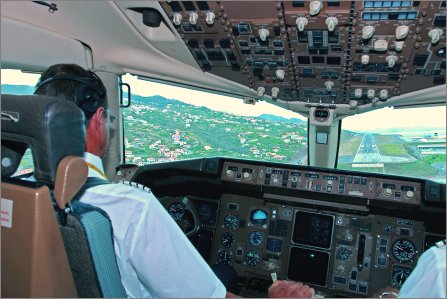Modifications to eliminate landing control anomalies
Boeing 757 operators will have to install control wheel damper assemblies and leading-edge vortex generators, or vortilons, to prevent roll oscillations near touchdown, under a proposed US Federal Aviation Administration ruling.
The agency says 11 incidents have been reported where 757s experienced unintended roll oscillations on final approach, just before landing. One incident resulted in a nose gear collapse after a hard landing; another involved a tail strike that ended in an aborted landing.

The modifications are to eliminate unintended roll near touchdown © PETERFRAGERSTROM
“These roll oscillations occur when the pilot makes large, rapid movements of the control wheel, and the aircraft does not respond as expected,” says the FAA in a notice of proposed rulemaking (NPRM). “Boeing has developed a damper for the control wheel that reduces the likelihood of these roll oscillations by providing resistive force to large, rapid control wheel movements that exceed a set value.”
Vortex generators can also reduce oscillations, the FAA says. “We have also received flight-test data indicating that one potential cause of these unintended roll oscillations occurs when airflow over the outboard trailing-edge flap separates due to the movement of the spoilers resulting from large control wheel inputs. Abrupt control wheel inputs to counteract the resulting roll can lead to roll oscillations of increasing magnitude.”
Boeing has developed vortex generators that “create vortices over the flap surface and help to mitigate a sudden and premature airflow separation when the flaps are set in landing configuration and the spoilers forward of the flaps are deployed,” says the NPRM.
The manufacturer has previously issued service bulletins recommending wheel damper assembly and vortex generator installation.
The FAA notes that the proposed rulemaking is considered to be an interim action, and that Boeing is “currently investigating an additional modification that may further reduce or eliminate the unsafe condition... Once this modification is developed, approved, and available, [the FAA] may consider additional rulemaking.”
Compliance is expected to cost between $4.8 million and $6.5 million for installation of the wheel damper assembly on the 578 US-registered 757-200 derivatives, predicts the FAA. The cost for the 51 US-registered 757-300s in operation is expected to be $588,000.
Vortex generator installations are expected to cost $2.1 million for affected aircraft. The ruling will affect US-registered aircraft only. The NPRM is open to public comment until 17 March.
JOE SINGLETON / WASHINGTON DC
Source: Flight International























